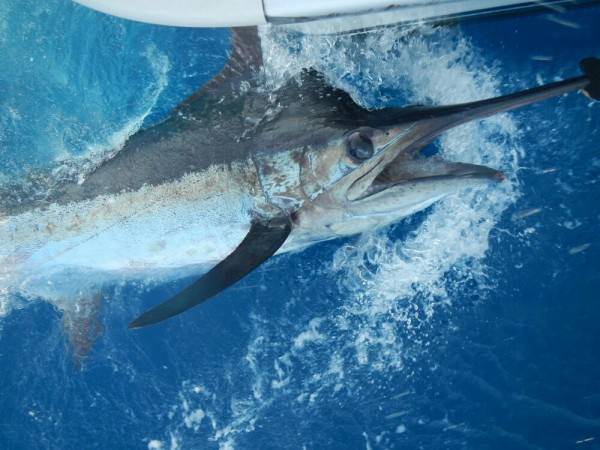Marlin

Classification of the billfish family:
Race Sailboats (Istiophorus)
Atlantic sailfish (Istiophorus albicans)
Indo-Pacific sailfish (Istiophorus platypterus)
A genus of Marlins (Makaira), or makiri
Black Marlin (Makaira indica), or white Marlin
Indo-Pacific blue Marlin (Makaira mazara)
The Atlantic blue Marlin (Makaira nigricans), or blue Marlin
Family Spearmen (Tetrapturus)
Atlantic white Spearman (Tetrapturus albidus), or Atlantic white Marlin
Korotkiy Spearman (Tetrapturus angustirostris), or Korotkiy Marlin, or korotkovata fish-spear
Striped Spearman (Tetrapturus audax), or striped Marlin
Mediterranean Spearman (Tetrapturus belone), or Mediterranean Marlin
Southern European Spearman (Tetrapturus georgii), or North African Spearman
Small Spearman (Tetrapturus pfluegen), or zapadnotekhasskaya Spearman
Blue and black are the biggest representatives of the family, reaching a weight of 750-800 kg and growing up to an average of 2 m, and the largest and 4. Impressive weight, streamlined shape, powerful folding fins piercing the water sword — it all helps Marlin to reach an amazing speed, allowing him to hunt successfully even at flying fish.
The maximum recorded weight of a blue Marlin - 818 kg, a record weight for striped Marlin is 224,1 kg, the largest black Marlin the weight of which amounted to more than 707 kg., was caught off the coast of Peru.
The Atlantic blue Marlin is the most thermophilic species in the family. Found only in the Atlantic ocean. The latitudinal distribution is seasonal. The range from 45° North to 35° South latitude. Less common in the Eastern Atlantic where it mostly occurs off the coast of Africa from 25° North to 25° South latitude. Usually lives in waters warmer than 24 °C, but observed in surface waters with the temperature from 21.7 °C to 30.5 °C. the Area expands in the warmer months and return closer to the equator in colder months. Blue Marlin spend most of their lives in open waters away from the coast, undertaking extensive migrations, including re, between the Caribbean Islands and Venezuela, and between the virgin Islands and West Africa.
Black Marlin is found mainly in the far pristroennyh and coastal waters of the Pacific and Indian oceans and are especially common in the East China sea, inner seas of Indonesia, in the coral sea and off the coast of Mexico and Central America.
Striped Marlin is limited to tropical and warm temperate waters of the Pacific and Indian oceans. One of the most successful places for fishing where you can meet that representative Marlin, are the waters of Costa Rica. Extremely rare in the Equatorial zone.
White Marlin occurs throughout the Atlantic ocean, including the Gulf of Mexico, Caribbean sea and even the Western part of the Mediterranean sea.
There is nothing more fun than hunting for Marlin. The most effective method of capture is trolling. The Marlin swallows the bait, and then begins the struggle unrealistic. Individual can, jumping out of the water around the boats circling for hours. For fishing you will need 5-6 spinning, like a fan spreading astern. Equipped with fishing rods with lures or baited with fragments of fresh fish. While hunting is used by large streamers, surface lures and octopus. The angler must be prepared for the fact that Marlene does not give up and fast for their freedom can fight for hours. To catch him is very difficult. According to statistics, over 50% of leads are broken. The reason is the structure of the head of this fish, such a structure of the head that no one is hook do not get caught for sure. To the coveted trophy was pulled out of the sea, need a whole team of experienced fishermen.
Related tours
Casa Vieja Lodge
5-star CASA VIEJA LODGE is one of the most popular among fishermen who come for fishing for sailfish in Guatemala.Big game fishing in island San Vicente
Cape Verde is often called the capital of the Marlin, which is caught all year round. And the best places to hunt them - the Strait between the Islands of Sao Antao and Sao Vicente is very well known to avid anglers. The average weight produced here Marlin up to 200 kg but not uncommon, especially towards the end of summer and autumn specimens of more than 400 - 500kg.